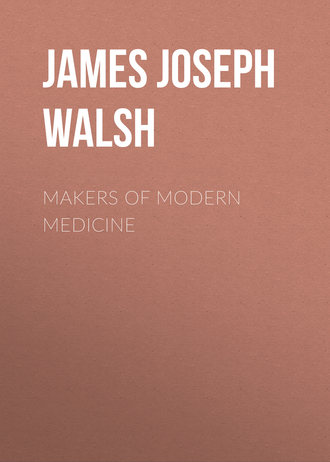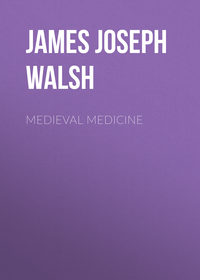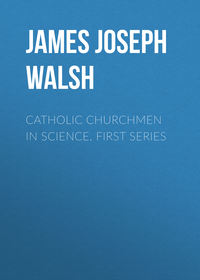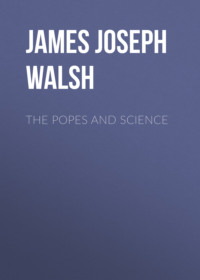 полная версия
полная версияПолная версия
Makers of Modern Medicine
While recognizing all the difficulties of medical practice and the essential individualization of all its problems, Dr. Graves had little or no patience with the skeptic who thought that medicine could accomplish but little for the cure of many ailments. He said once before the Medico-Chirurgical Society:
"Many, indeed, aiming at acquiring the character of medical skeptics, think they exhibit proofs of superior discrimination when they, with apparent candor, make the confession that the more they see the less confidence they have in the resources of medicine. This confession should be interpreted not as a reproof of our art, but as a testimony of the want of skill of the would-be philosophical asserter of so false a proposition. No, God be praised, our predecessors have not toiled in vain; the anxious experience of ages has not been recorded to no purpose; our art is in truth boundless in resources and, when applied with ability, most successful. There are, indeed, some acute and many chronic diseases which baffle our powers of diagnosis, and defy our modes of treatment; such appear to be, however, not numerous when compared with the great mass of cases capable of cure or alleviation. The medical skeptic, however acute his powers of reasoning may be, and however he may labor to render plain subjects obscure and direct facts ambiguous, can never rob the good practitioner of the pure, the inward joy he feels when conscious that he has snatched a patient from the jaws of death."
Knowing that such were his ideas with regard to the practice of medicine, it is all the more interesting to review the system of teaching that Graves considered most likely to produce genuine practitioners of medicine. Those who have been mainly concerned with the reform of medical education here in America in recent years can scarcely fail to be struck with the appropriateness of Graves' ideas on this subject nearly a century ago. When a very young man he did not hesitate to express his deprecation of the conventional and artificial methods of medical instruction in his own time, and he anticipated what is best in the methods that have gradually come into vogue at the end of the nineteenth and the beginning of the twentieth centuries. His views will always remain a suggestive storehouse of thought for those who have the higher medical education at heart.
In his introductory lecture at the opening of the Medical course at the Meath Hospital in Dublin in 1821, he declared very definitely what he considered to be the principal aim of the medical student:
"Students should aim not at seeing many diseases every day; no, their object should be constantly to study a few cases with diligence and attention; they should anxiously cultivate the habit of making accurate observations. This cannot be done at once; this habit can be only gradually acquired. It is never the result of ability alone; it never fails to reward the labors of patient industry. You should also endeavor to render your observations not only accurate but complete. You should follow when it is possible every case from its commencement to its termination; for the latter often affords the best explanation of previous symptoms and the best commentary on the treatment."
Graves was inculcating in principle what Corrigan and himself and Stokes were to exemplify so thoroughly in practice in the next few years. Before the end of the decade in which this address was delivered at the Meath Hospital, Corrigan at the little Jervis Street Hospital, where there were only beds for six medical patients altogether, was to make his great discoveries with regard to aortic disease, and to lay the sound basis of the diagnosis of affections of the heart for all time. There are many passages in this address of Graves that might well serve for warnings to the present day and generation as regards methods of medical education which do not include sufficient practical teaching. He said, for instance:
"The chief objection to our present mode of teaching is that, however well inclined the student may be, he is never obliged to exercise his own judgment in distinguishing diseases and has no opportunity of trying his skill in their cure, and consequently at the end of his studies he is perhaps well grounded in the accessory sciences–is a perfect medical logician–able to arrange the names of diseases in their classes, orders and different subdivisions; he may be master of the most difficult theories of modern physiologists; he may have heard, seen and, if a member of the medical society, he may also have talked a great deal; but at the end of all this preparation what is he when he becomes a full doctor?–a practitioner who has never practised!"
These words have quite as suggestive applications to most phases of our modern education as they had to that of Graves' time. There are other passages that bear so significant a meaning in this regard that one can scarcely refrain from quoting:
"Our present method of instruction is indeed very useful and nothing better can be devised for a beginner; but for the more advanced student it is by no means sufficient, nor is it calculated to give him practical experience, without which all other acquirements are of no avail. I say it does not give him experience, because he has at no time been charged with the responsibility of investigating a case for himself, and by himself; because at no time has he been called on to make a diagnosis, unassisted by others; and above all because he has never been obliged to act upon that diagnosis and prescribe the method of treatment. If those who had been thus educated, and who had been made doctors upon so slender a foundation, were to confess the truth, we should be presented with a picture calculated to excite dismay if not a stronger feeling. How many doubts and distracting anxieties attend such a man at his first patient's bedside. If the disease be acute and life in imminent danger, and if he shrink under this sudden and unusual load of responsibility, he gains little credit for professional ability. If, on the contrary, inexperienced as he is, he assumes that decision of judgment, that energy of practice which experience alone can confer, is it not probable that the result will be still more disastrous?"
Graves' last days and the circumstances of his death and burial are given by Professor Stokes, his great personal friend, and himself one of the most distinguished physicians of his time. We quote the concluding paragraph of Professor Stokes' biographical notice:
"It was in the autumn of 1852, he being then in his fifty-seventh year, that the symptoms of the malady which was to prove fatal first showed themselves. In the following February he began to succumb to the disease. Although at times his sufferings were great, yet he had many intervals of freedom from pain. And he then showed all his old cheerfulness and energy. To the very last he continued to take pleasure in hearing of any advance of knowledge that tended to ameliorate the condition of man, or to throw light on his relations to a future state. In this latter point of view, the discoveries of Layard greatly interested him, as illustrative of the Sacred History; and thus he was permitted to fill up the intervals of his sufferings, even to the last; for his mental faculties never failed or flagged,–a mercy for which he often expressed a fervent gratitude; and so he was providentially enabled to review the past, and to form a calm and deliberate judgment on the religious convictions of his earlier years. And once the truthfulness of these were ascertained, he adhered to them with that earnestness which characterized all his decisions.
"It was after the attainment of this state of patient expectation that one who was dear to him expressed a prayerful wish for his recovery. 'Do not ask for that,' he replied; 'it might prove a fatal trial.'
"His mind having become thus satisfied he made few remarks on these subjects, except in reply to the inquiries of others. Thus, when referred to the prophetic illustration of purifying and redeeming love, 'A fountain shall be opened for sin and for uncleanness,' 'No,' he said, 'not a fountain, but an ocean.'
"On the day before his death he desired (a second time) to partake of the Holy Communion, with his family. When some explanations were commenced, he answered, 'I know all that; I do not regard this as a charm, but I wish to die under the banner of Christ.' Feeling himself sinking, he asked for prayer, and a petition was offered suitable to his condition; but he seemed to long for something more and, when questioned, replied, 'I want some prayer that I know, some of the prayers of my youth, some of my father's prayers.' The Litany was commenced, he immediately took up the well-known words, and when the speaker's voice faltered he continued them alone, and distinctly, to the end of the strain, 'Whom thou hast redeemed with thy most precious blood.'
"On the twentieth day of March, 1853, and without renewed suffering, he ceased to breathe.
"His tomb is in the cemetery of Mount Jerome. It bears the following inscription dictated by himself:
"ROBERT JAMES GRAVES,Son of Richard Graves, Prof. of Divinity,Who,After a Protracted and Painful Disease,Died in the Love of God, andIn theFaith of Jesus Christ."William StokesVery closely associated with the name of Robert Graves in all that made the Irish School of Medicine influential for good, about the beginning of the second quarter of the nineteenth century, is that of William Stokes. Stokes' work on Diseases of the Chest and, later in life, his treatise on Diseases of the Heart and Aorta stamp him as one of the great physicians of all time. His name is assured of immortality in medicine, because with that of the well-known Scotch physician, Cheyne, who came to Dublin late in the second decade of the nineteenth century, it is associated in the term most commonly used for a form of breathing, having special diagnostic and prognostic significance in certain serious diseases, and which is known as Cheyne-Stokes respiration. Even more interesting, however, than Stokes the physician, is, as we shall see, Stokes the man, and all that he stood for in his generation in Dublin, during a long life.
William Stokes was of a family that had long been distinguished in Dublin for scholarship. While his ancestors came originally from England, five generations occupied more or less prominent positions in the public life of Ireland, and they had lived in Dublin for more than one hundred and fifty years before Stokes began to be prominent in Irish medicine. His father, Whitley Stokes, had been a scholar and Senior Fellow of Trinity College, and was prominent in the scientific, political, and literary circles of the Irish capital at the end of the eighteenth and the beginning of the nineteenth century. He had been a member of the United Irishmen, but fearing that the revolutionary principles that were being propagated would only bring about an ineffectual rebellion, he separated himself from them, though years after when the United Irishmen came under the ban of the English government his previous connection with them cost him suspension from the fellowship. Later on, however, Whitley Stokes became the Regius Professor of the Practice of Medicine at Trinity College, a chair which he held until succeeded in the early forties of the nineteenth century by his son, William, the subject of this sketch. Something of the character of the man can be judged from the fact that though he was a distinguished physician and interested in every branch of science, taking an active part in the foundation of Trinity College Botanical Gardens, and being one of the founders of the Zoological Garden in Phoenix Park, he was also the author of a prize essay in reply to Tom Paine's Age of Reason, which was then attracting so much attention.
Our William Stokes was the second son of Whitley Stokes, and was born in Dublin in 1804. Like many another distinguished investigator in science, he was not looked upon as a bright student as a boy, and indeed could be prevailed upon to interest himself only very slightly in what is usually considered to be the absolutely necessary fundamental work in education. He had a great love for poetry and romance, which indeed he carried with him all his life. The Scottish Border Ballads were his favorite reading, and he spent days in committing them to memory. Almost needless to say his apparent indolence and disinclination to any steady, methodical system of study were, as his son, the late Sir William Stokes, records in his biography of his father, sources of real concern to his parents, and caused his mother specially much anxious thought. One day while reading his favorite author, Sir Walter Scott, he fell asleep–to be awakened shortly after by some warm drops falling on his face. He started up to find his mother bending over him. It was her tears that had awakened him. Stung with remorse at having been the cause of so much sorrow to the mother whom he loved very dearly, his nature underwent an immediate and salutary change, and the dreamy, indolent boy became thereafter the ardent and enthusiastic student.
Stokes amply made up for any neglect of study there might have been in his boyhood days as soon as he entered upon the medical course to which he felt called. Here he came to be looked upon as one of the most ardent and painstaking of students.
His preliminary medical studies were begun in Dublin at the Meath Hospital. Chemistry he learned in the laboratory of Trinity College and anatomy in the Royal College of Surgeons. After spending several years thus he went to Glasgow, where for two years more he was occupied mainly at chemistry in the laboratory of Professor Thompson. Like most of the young Irishmen of his time, he next proceeded to Edinburgh in order to complete his education in clinical medicine and, if possible, obtain his medical degree from that famous institution. It was at Edinburgh, under the magnetic influence of that great teacher, Allison, that Stokes began to develop the rare powers of original observation which at an early age placed him in the front rank of the best medical men of the time.
It is interesting to note that before he left Edinburgh he published his first medical work, a treatise on the use of the stethoscope, which was undoubtedly the means of bringing that instrument–and with it Laennec's fruitful system of physical diagnosis by means of auscultation–to the general notice of the English-speaking medical profession. Even after all that has been written on the subject, it remains a very valuable little book. It was dedicated to the famous Cullen, who had already published a series of cases which had been illustrated by the use of the stethoscope, and to whom Stokes probably owed the idea of the need for a formal little treatise on the subject. It is typical of the slow adoption of medical novelties even when they are of great importance that more than ten years afterward, old-time, though distinguished, physicians not infrequently made fun of Stokes for spending so much time in the study of cases with the stethoscope, since in their opinion it was little more than a toy. This was done in no bitter, carping spirit, but with the most friendly complacency and condescension. Stokes, however, intensely practical in his way, realized the value of the instrument, and as the result of his teaching it soon began to be more generally used; thus introducing into English-speaking medical circles that exact knowledge of diseases of the chest which can only be obtained by means of this little instrument and the methods of auscultation which are associated with it.
Immediately after graduation, Stokes settled down in his native city to practise. In 1826, when Stokes was only twenty-two, Dublin was visited by one of those epidemics of typhus fever which were so common in the first half of the nineteenth century, and which consisted evidently, at least to a great degree, of what we now call typhoid fever, but intermixed with many cases of the real, dread typhus. The mortality in such epidemics, as we have reason to know from statistics here in New York, was always over twenty-five per cent, and often reached far above fifty per cent. The manner of contagion was unknown, only it was very well understood that those much in contact with the patients were likely to contract the disease. Among the poorer classes in Dublin the fever raged with virulence, but young Stokes devoted himself to the care of patients to an extent that severely taxed his physical powers of endurance. He devoted himself especially to the poorer classes. He did not contract the fever during the height of the epidemic in 1826, but he did in 1827, when it recurred, but fortunately he suffered in the mild form.
An epidemic of another disease, Asiatic cholera, the danger from which has been almost entirely removed by the progress of scientific medicine in modern times, followed not long after. It showed itself in Dublin, when Stokes was about twenty-five. He it was who recognized the first case of the disease, and sounded the note of warning that probably saved many lives by calling attention to the danger that was just beginning. Once more he devoted himself to the care of the patients, and, as with regard to typhus fever, wrote an account of his experiences, which is in itself a valuable medical document that shows the powers of observation of the young medical man.
Stokes spent himself in labor for the poor, and his deep interest in their welfare led him to sacrifice much time in order to organize medical charities for his unfortunate countrymen during the sad years of that awful fifth decade of the nineteenth century. His interest in this matter of organization led him also to realize how much might be accomplished by public hygiene and efficient government sanitation. He recognized too how much would be accomplished along these lines if men were given proper training to make them specialists in these subjects. To Stokes then, almost more than to any other man, is due the development of public sanitation as a special science, and its organization for the proper safeguarding of public hygiene.
His efforts, especially with regard to the physicians of Ireland, who so nobly sacrificed, not unfrequently at the expense of other practice, their time, health, and often even their lives, in order to aid their stricken countrymen, form one of the best monuments to his tender sympathy and his goodness of heart as a man. His testimony before the Parliamentary Committee was at this time of the utmost value in securing due recognition of their services.
In 1843, when the Medical Charities Bill was brought forward, Stokes and Cusack united in the effort to procure for these devoted men an amelioration of the conditions under which they labored. They repaired to London to give evidence on the subject before the House of Commons. Both these friends had had to deplore the loss of many of their dearest and most promising pupils, who, after a short experience of country practice, had fallen victims to fever contracted in the discharge of their duties. They pleaded that in all justice the remuneration for attendance on fever hospitals and dispensaries should be fixed at a liberal scale, and that some provision ought to be made for the widows and children of gentlemen who had lost their lives in the public service. They collected statistics which proved that during a period of twenty-five years the mortality of the medical practitioners of Ireland was twenty-four per cent., while in most instances the cause of death was typhus fever. They showed that, on the authority of Inspector-General Marshall, the comparative mortality of combatant officers in the army was less than half that, amounting to only ten and a quarter per cent. It was little to be wondered at that William Stokes should say, in answer to the chairman's question regarding the existence of any special risk to the medical officer in Ireland: "Such a number of my pupils have been cut off by typhus fever as to make me feel very uneasy when any of them take a dispensary office in Ireland. I look upon it almost as going into battle." Again he observes: "The medical practitioners in Ireland are placed in a position very different from and far more serious than that of their brethren in Great Britain. . . . . The Irish physician is often exposed to contagion in its most concentrated force when himself under the influence of cold, wet, fatigue, and hunger, as he labors among the poor, passing from hovel to hovel in wild and thinly-populated but extensive districts. He has often to ride for many hours in the worst weather, and at night, enduring great fatigue, while himself a prey to mental as well as physical suffering; for if we add to such labor the injurious influence which the knowledge of danger must have on the system of a man feeling that he is struck down by the disease under which he has seen so many sink, and tortured by the thought of leaving a young family unprovided for, we can understand how it happens that the country is so often deprived by death of so many of its best educated and most devoted servants."
Perhaps the most interesting phases of Stokes' purely medical work during the first part of his career is his treatment of the subject of consumption. When not quite thirty-three he wrote a treatise on the diagnosis and treatment of diseases of the chest. His familiarity with the work of Graves and of Auenbrugger gave him command of all the modern methods of physical diagnosis, so that he was able to study tuberculosis to the best possible advantage and with the least possible chance of too favorable judgment with regard to its cure. Notwithstanding the accuracy of his knowledge, however, he insisted that the disease was curable, and that the important point with regard to it was the recognition of it as early as possible, in order that the patient might be given the best chance for life.
At that time most physicians considered tuberculosis to be an hereditary disease, without any idea of its being possibly contagious. Acceptance of heredity seemed to set the stamp of inevitable fatality on the heads of victims of the disease. To announce the curability of tuberculosis then was to run counter to all the medical traditions of the time, and Stokes in doing so must have had in support of his teaching many observations of patients who had been cured notwithstanding the fact that they were assured sufferers from this supposedly fatal disease. We know that Stokes was surely correct in his judgment in this matter, and realize too that his method of treatment, which included abundant feeding and long hours each day in the outdoor air, comprised the best elements of the modern treatment of tuberculosis.
Perhaps one of the most striking anticipations of what is apt to be considered quite modern in medicine is Dr. Stokes' descriptions of the methods by which he considers certain forms of heart weakness, especially that incident to incipient fatty disease, should be treated. His directions are almost exactly those which have made the names of the Schott Brothers known throughout the world during the last twenty-five years. To have anticipated our modern views with regard to tuberculosis, its curability, and the best methods of treatment shows how thoroughly Stokes had studied his cases of consumption. That the same man should also have been able to work out the details of treatment for heart weakness is a triumph that indicates better than anything else perhaps the genius of the physician not only in the observation of disease, but above all in that more important part of medicine–the proper application of therapeutic principles.
Stokes observes, "In the present state of our knowledge the adoption of the following principles in the management of a case of incipient fatty disease seems justifiable:
"We must train the patient gradually but steadily to the giving up of all luxurious habits. He must adopt early hours, and pursue a system of graduated muscular exercises; and it will often happen that, after perseverance in this system, the patient will be enabled to take an amount of exercise with pleasure and advantage which at first was totally impossible owing to the difficulty of breathing which followed exertion. The treatment by muscular exercise is obviously more proper in younger persons than in those advanced in life. The symptoms of debility of the heart are often removable by a regulated course of gymnastics or by pedestrian exercise, even in mountainous countries, such as Switzerland, or the Highlands of Scotland or of Ireland. We may often observe in such persons the occurrence of what is commonly known as 'getting the second wind;' that is to say, during the first period of the day the patient suffers from dyspnoea and palpitation to an extreme degree, but by persevering, without overexertion, or after a short rest, he can finish his day's work and even ascend high mountains with facility. In those advanced in life, however, as has been remarked, the frequent complications with atheromatous disease of the aorta and affections of the liver and lungs must make us more cautious in recommending the course now specified."











